Date: circa 1980s
Location: Cincinnati, Ohio
Source: via Cincinnati State Archives
What do you see here?
Date: circa 1980s
Location: Cincinnati, Ohio
Source: via Cincinnati State Archives
What do you see here?
NASCAR Cup Series
Xfinity 500
Martinsville Speedway
Sunday, October 30, 2:00 p.m. ET

TV: NBC
Radio: PRN, SiriusXM
NASCAR Xfinity Series
Dead On Tools 250
Martinsville Speedway
Saturday, October 29, 3:00 p.m. ET
TV: NBC
Radio: PRN, SiriusXM
Formula 1
Mexico City Grand Prix: FP1
Autodromo Hermanos Rodriguez
Friday, October 28, 1:55 p.m. ET
TV: ESPN News
Formula 1
Mexico City Grand Prix: FP2
Autodromo Hermanos Rodriguez
Friday, October 28, 4:55 p.m. ET
TV: ESPN News
Formula 1
Mexico City Grand Prix: FP3
Autodromo Hermanos Rodriguez
Saturday, October 29, 12:55 p.m. ET
TV: ESPN News
Formula 1
Mexico City Grand Prix: Qualifying
Autodromo Hermanos Rodriguez
Saturday, October 29, 3:55 p.m. ET
TV: ESPN News
Formula 1
Mexico City Grand Prix
Autodromo Hermanos Rodriguez
Sunday, October 30, 3:55 p.m. ET
TV: ESPN
News and Notes:
Ticket information for the 2023 Las Vegas Grand Prix have been released. Grandstand or general admission tickets can only be purchased as three-day passes and will include food and non-alcohol beverages. Premium tickets offer multi-day passes and include all-inclusive food and beverages. Ticket sales for the public begin on November 5, and American Express members get can tickets starting on November 3.

I suspect that tickets for the 2023 Las Vegas Grand Prix will be priced out of my tax bracket. This year was the inaugural Miami Grand Prix and The Sporting News broke down single race ticket prices from various ticket services:
TicketSmarter
Ticketmaster
StubHub
Vivid Seats
SeatGeek
GameTime
If Miami’s ticket prices foreshadow next season’s Las Vegas Grand Prix I will only be able to witness the race from my couch in Phoenix. That’s not a bad thing because I have a comfortable couch, but I’d like to see an F1 race in person without taking out a mortgage.
The Easybeats had a hit in America with “Friday on My Mind” in 1967. I first became aware of the song from David Bowie’s cover, but the original is solid. The band’s rhythm guitarist was George Young, the older brother of soon-to-be-famous Angus and Malcom Young of AC/DC, and George would go on to co-produce several of their early LPs. What does this have to do with cars? The below AutoHunter vehicles are on my mind for Friday.
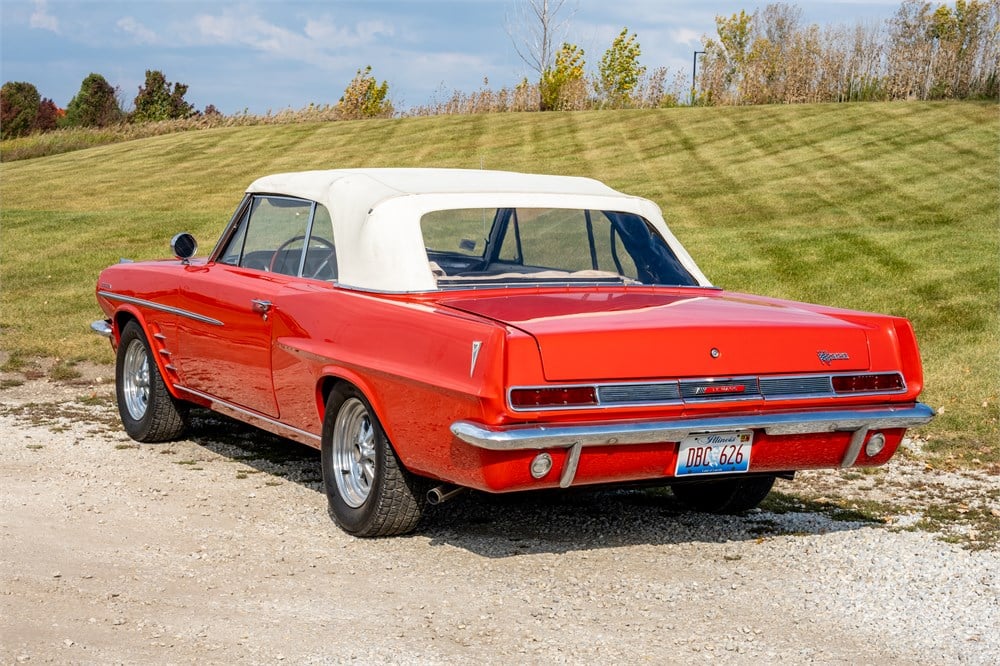
1963 Pontiac LeMans Convertible
These are a curiosity to me. Initially part of a wave of “senior compacts” from General Motors, they eventually became proper mid-size vehicles in 1964. They featured a transaxle that was unique for a front-engined car at the time in Detroit. Pontiac even installed the 421 Super Duty in 11 or 12 of these cars, including some wagons, which is kinda crazy.

For 1963, Pontiac continued to offer the inline-four but replaced the Buick aluminum V8 with a new 326 (though it actually measured 336ci for 1963 only) with up to 280 horsepower. The one in this 1963 LeMans has been bored to 350ci (a size that Pontiac wouldn’t offer until 1968) and features several upgrades like a more radical camshaft from COMP Cams, forged JE Pistons and a Tri-Power intake. In some respects, this Poncho comes off as a prototype of the GTO that would come the following year after some subversive noodling from John DeLorean.
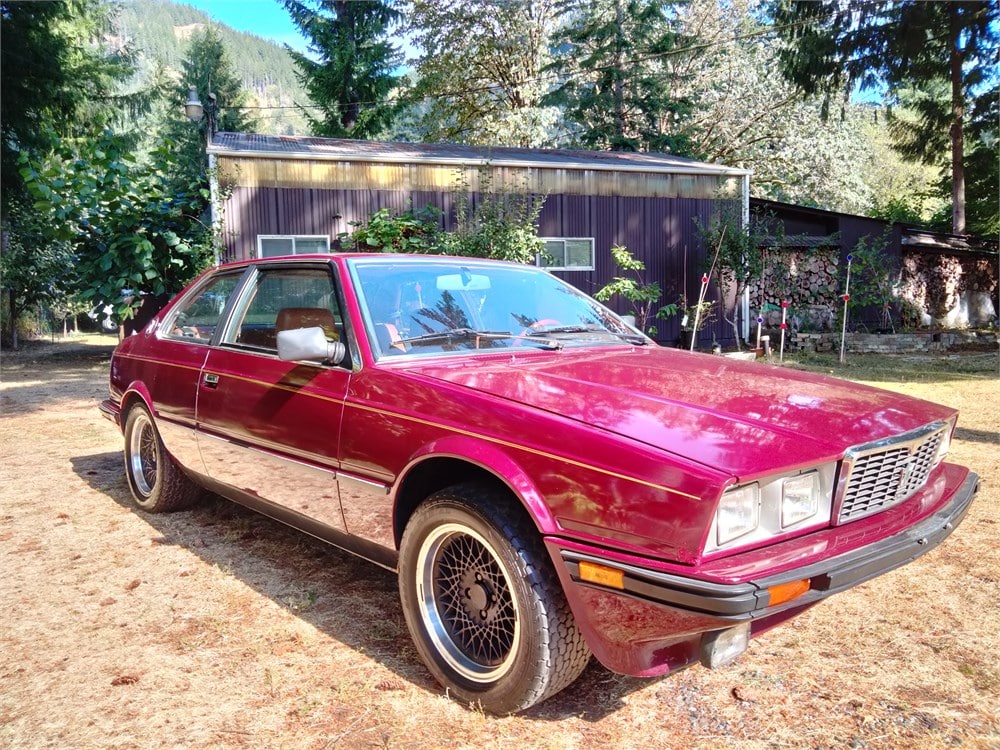
1984 Maserati Biturbo
I remember these cars when new. They were not common, but they helped carry the Maserati brand during its lean years. A memory I have is going to the Philadelphia Auto Show and being amazed how cramped the interior was. My dad had a soft spot for the Quattroporte from the 1970s, and the Biturbo shared similar styling in more compact form, though he never gravitated to these. Probably a good thing since he wasn’t so much a “car guy” as much as a guy with a passing interest in cars, and I’m sure he wouldn’t have tolerated its quirks.
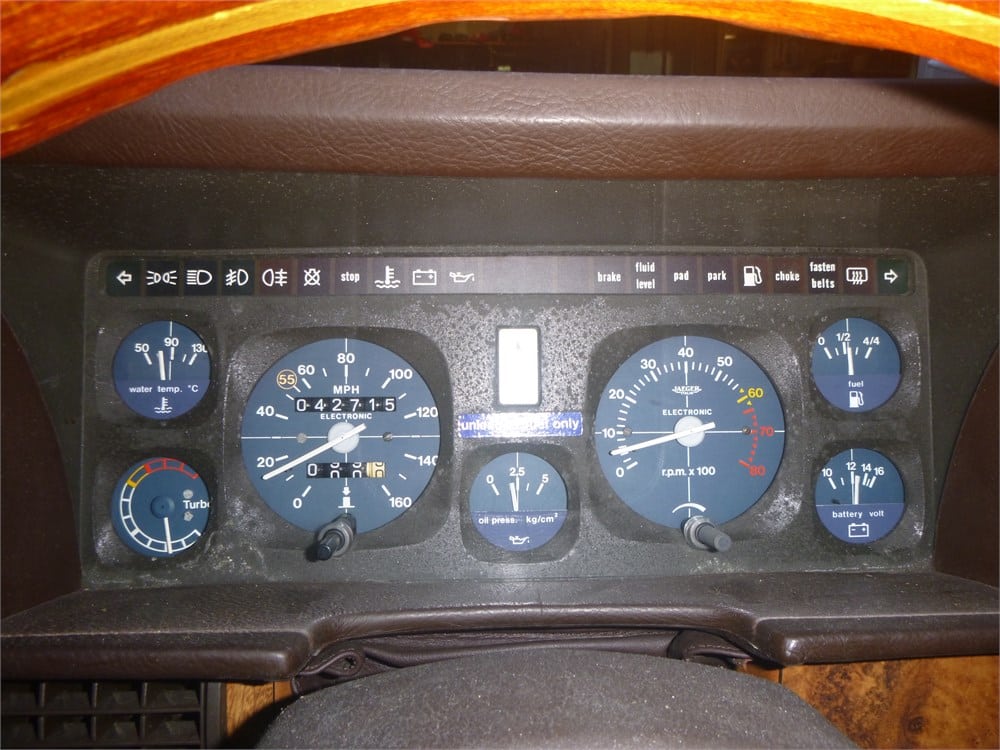
According to this webpage, 4,577 Biturbos were exported between 1983-85, so it stands to reason why sightings were infrequent, but how many of those featured the five-speed manual like this 1984 Biturbo? It features the twin-turbo 2.5-liter V6 with 182 horsepower, which was quite good in the era. The seller claims to have owned the burgundy Italian for 30 years, with the odometer currently showing 42,000 miles. If there is such thing as a car with brio during the Malaise era (though technically the guy who coined the term cuts it off at 1983), this one has it in spades.
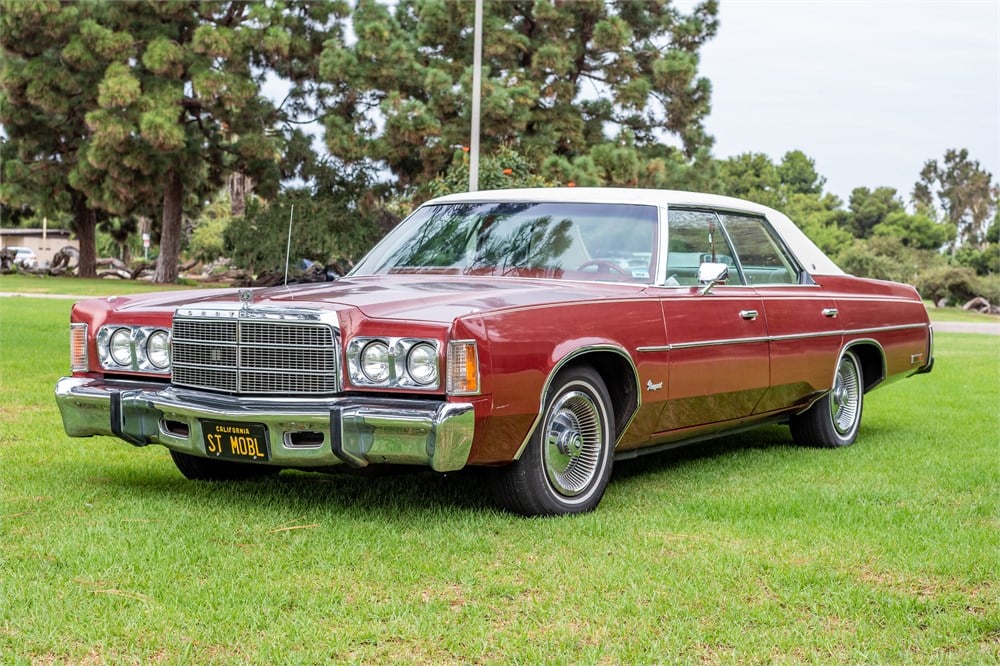
1978 Chrysler Newport
These were everywhere, and then time took over. Like General Motors, I think the Chrysler Corporation grew the styling of its large cars nicely throughout the decade. I wouldn’t be surprised if Mopar fans preferred the styling of these to the original 1969s, which come off as somewhat massive and bulky in comparison. Nineteen seventy-eight also was the last year for the C-body until Chrysler’s R-body carried the full-size torch for the corporation thanks to clever packaging of the midsize B-body platform.
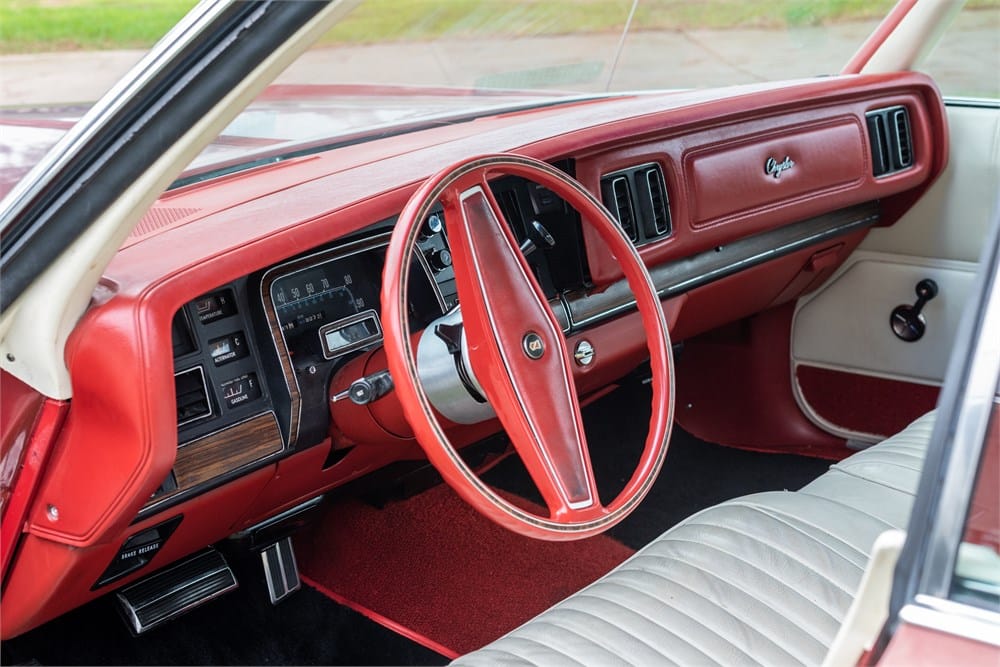
This 1978 Chrysler Newport features the big-block 400 four-barrel hooked to (what else?) a TorqueFlite automatic. Nothing’s quite outstanding about it other than it being one of the last of the behemoths, which goes a long way to my eyes. A nicely integrated RetroSound audio system helps make cruising more contemporary in case you prefer Fall Out Boy over Frampton. Sometimes you find cars like these painted in primer and modified to resemble an urban assault vehicle, but I hope the winner of this AutoHunter auction respects its condition as it sits.
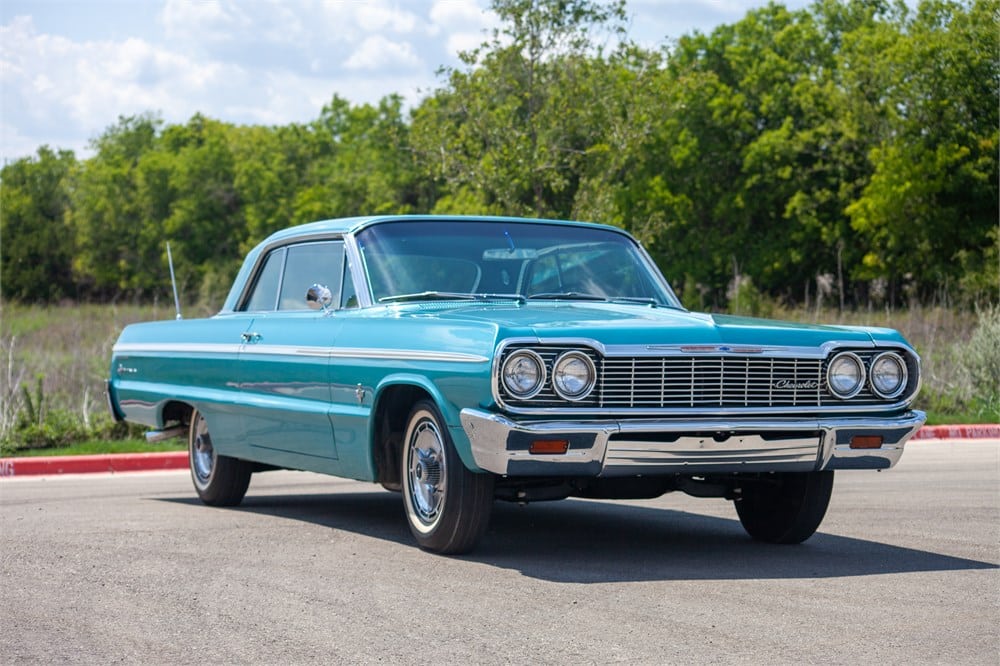
1964 Chevrolet Impala Super Sport
Before there was a GTO, there was the 409. The Beach Boys made it legit for the general public, though Chevrolet didn’t need the help because no one had more dealerships or more customers. For 1964, the 409 was available in three tunes of horsepower: 340, 400, and 425. Both the latter two featured solid lifters and mostly differed by carburetion, with the 425-horse version featuring dual-quads. Though available in any full-size Chevy, most 409s seem to have been installed in Super Sports versus the racier (read: cheaper and lighter) Biscayne and Bel Air. Many folks think of the Super Sport as a performance model, but from 1962-68 it was a trim level or package as the 230 six was available for most years.
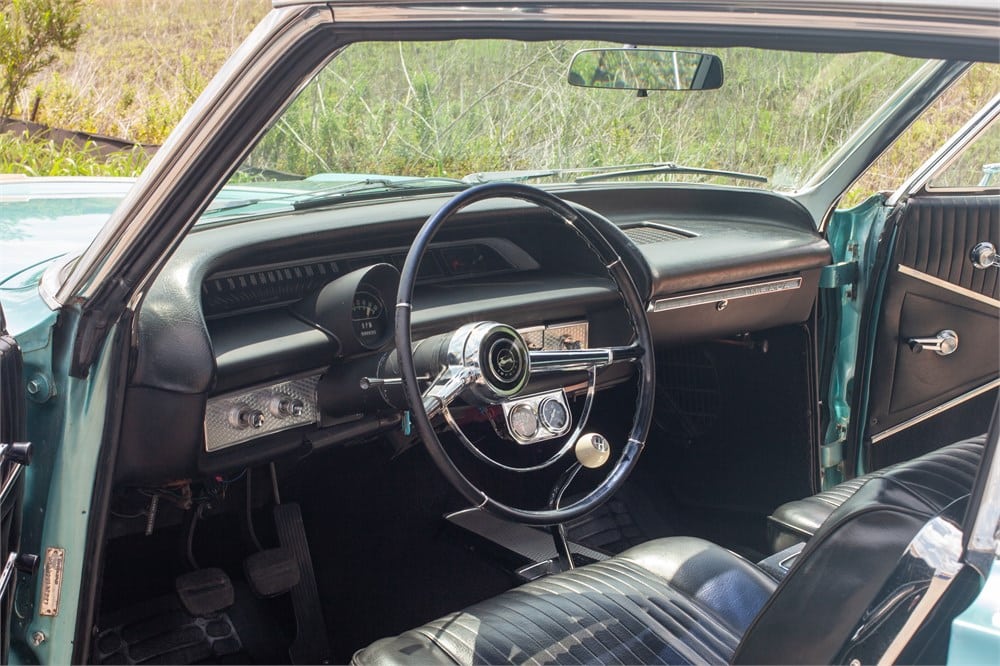
This 1964 Chevrolet Impala Super Sport includes the M20 wide-ratio four-speed, which actually was an option over the standard three-speed manual on the column. Manual steering and brakes makes this Chevy somewhat tough to handle in certain conditions and somewhat unusual considering the Super Sport was the top trim level. Overall, this is a very legit piece of early muscle, a worthy competitor to the GTO before the Chevelle SS 396 reached regular production status in 1966.
From its inception more than 130 years ago, France’s automotive industry has stood apart from all others. Sometimes it set precedents that all others followed, like establishing the front-engine/transmission/rear-wheel-drive layout (“Le Système Panhard“) circa 1892. Other times, it stood alone with unique requirements that no other country with an automotive industry has adopted. France’s vehicular use of selective yellow forward lighting between 1937 and 1992 was a key example of the latter, and the reason for it might seem as murky as the darkness it was designed to penetrate.
In the first couple decades of global automotive production, forward-facing road illumination was largely the same around the world: kerosene-fueled oil lamps (more useful as signals to others than actually lighting the path of travel) were followed by those lit using acetylene gas, and both were ultimately replaced by electric-powered light bulbs. As headlamps grew more powerful, regulations were introduced that mandated how much light could be thrown and where in an attempt to limit glare for oncoming traffic.
The ongoing development of lighting output and beam patterns soon began to differ between American and European automakers, as David W. Moore discussed in his June 1998 thesis for The University of Michigan Transportation Research Institute, titled Headlamp History and Harmonization:
The early developments regarding vehicle headlamps were similar for the U.S. and Europe. Bulbs, lighting components, and beam patterns were essentially the same (Devaux, 1970; Meese, 1972; Maurer, 1980). However, in the 1920s two different approaches to automotive lighting began to appear. Much of this can be attributed to the more rapid increase in the vehicle population in the U.S. than in Europe. There were also differences in the use of the automobile. Americans more quickly adapted to mobility provided by the automobile, cities expanded, people began moving to the suburbs, and industry developed outside of the center of the downtown area. Americans drove their cars more on the open roads and did more night driving. Europeans retained more of the focus on the center city area and daytime driving. It is generally acknowledged that these factors contributed to the two different approaches (Nelson, 1954; deBoer, 1955; Meese, 1972; Olson, 1977). The two approaches can be summarized as follows:
(1) Primary emphasis: Develop as much light as possible to maximize seeing ahead of the vehicle. Secondary emphasis: Consider the other driver and try to do something to minimize glare. (U.S. philosophy)
(2) Primary emphasis: Do whatever is necessary to minimize glare in the other driver’s eyes. Secondary emphasis: Try to make sure there is available light to drive. (European philosophy)
By the mid-1930s, automotive headlamp performance had stabilized and advanced to the point that French legislators were moved to create a law that favored oncoming traffic over the vehicle operator. According to some sources, this decree was made in early November 1936, and it made yellow headlamps mandatory on new cars beginning April 1937; all roadgoing vehicles would need to be retrofitted with the new lighting by January 1939.
Moore explained this further in his paper:
In 1937 France legislated that headlamps emit (selective) yellow light (Jehu, 1954; Nelson, 1954). The French gave the following reasons for requiring yellow light: improvements in visibility under conditions of glare, and, even more important, reductions in fatigue under glare conditions. The yellow headlamp color was obtained by several different methods: a glass bulb with a different chemical composition, coatings on the glass bulb, a yellow headlamp lens, or a yellow filter. Because the yellow glass for bulbs reduced the emitted light intensity by about 18% (Jehu, 1954), this may have contributed to the perception of reduced glare from yellow headlamps. Many tests were run in different countries which failed to show any significant advantage in favor of yellow headlamps (Schreuder, 1976). However, within France, the mandatory use of yellow headlamps continued until the early 1990s.
The Daniel Stern Lighting website provides a clear explanation of what selective yellow light is, and why France mandated it: “By removing (filtering) the blue, indigo, and violet out of white light, we get selective yellow light.”
Stern goes on to explain the reason for this adoption: “This legislation was based on advice from the French Central Commission for Automobiles and Traffic, which in turn was based on experiments done by the French Academy of Sciences, concluding that selective yellow light is less glaring than white.”
The method by which this light was achieved varied depending on the prevailing technology of the day: Colored bulbs behind clear glass lenses gave way to halogen bulbs wearing yellow sleeves. An alternative was using a clear halogen bulb behind a Cadmium yellow glass lens. Motoring tourists visiting France from other countries in this period would cover their white headlamps with yellow filters or even paint the lenses yellow, lest they raise the ire of French road users and authorities.
Various sources posit this regulation was engineered to make native French civilian cars readily identifiable at night out of military concerns. Keeping in mind that it went into effect well before the outbreak of World War II, and that during the conflict automotive lighting was typically restricted at night to make vehicles less visible (and less of potential targets) to enemy aircraft, this seems a bit of a stretch.
France maintained its yellow lighting requirement until the beginning of 1993, when it changed to “white” lighting in agreement with other European national vehicle regulation standards. It seems that, like those glare-reducing night-driving glasses you see advertised on TV, the benefits of selective yellow headlamps no longer outweighed the drawbacks.
As Valeo Lighting spokesperson Francois Paillusseau explained in this 1990 Top Gear clip, “A recent survey told us more than 50 percent of the French people are ready to go to white.”
In a reversal of what happened in January 1939, cars already using yellow headlamps were permitted to retain them, although new one cars built from that point on had to feature white headlamps; new auxiliary fog lamps were legally allowed to remain yellow.
The car had to stop right that instant. On the way back from an afternoon of pumpkin picking, I spied something unexpected, something that should not have made me as giddy as it did, something that required fuller examination than a quick glimpse out the window at 45 miles-per-hour would have offered. Most people wouldn’t have given a second thought to a Jeep FC-150 in multiple hues of paint and rust, sitting on four flats, seen in passing on the back row of a used car lot. Me, I had to act like I’d just seen Sasquatch handing out $100 bills and cake.
Getting up close to the FC-150, I found exactly what I’d expected to find: a truck that looked like it just got pulled from somebody’s woods where it spent the last 40 years after being worked to death as a plow truck for the prior 20. Likely it sat in the way of a logger harvesting in the nearby forests. It had the smell of old upholstery that had molded and mildewed then been forgotten even by the mold and mildew. If it rolled on its four wheels it would have been a miracle, and I’m certain not a single nut or bolt on it would have come loose without using every blue word and a torch. Probably the only salvageable things left on it were the Jeep Forward Control badges behind each door. I did not offer to buy it, largely because it was a Sunday afternoon and nobody was around for me to offer to buy it from.
Photo by Daniel Strohl
I walked back to the car not exactly disappointed, but wondering what it is about rusty heaps that puts such a spell over people like me and the guy who rescued it and the dozen of you readers who want to know exactly where I spotted it so you can try to buy it off the guy. I should know better—y’all begging me for that location should know better—after a lifetime of having rust flakes bigger than Corn Flakes fall in our eyes, of spending more time loosening bolts than there are daylight hours, and of all the various setbacks that come with trying to coax a little more life out of cars and trucks most other people would consider too far gone.
This isn’t just another lamentation about living in a part of the world where cars are prone to rust. Even the largely rust-free 1993 Silverado I recently bought fought me every step of the way when I removed the plow, thanks to a combination of 30 years of semi-neglect, the galaxy-brain engineers at Fisher who decided every bolt needed to be paired with an inaccessible nut, and the tire shop employee who didn’t bother reading the installation instructions and just winged it with whatever bent and raggedy old tetanus-infused scrap metal he had on hand.
Now plowless, the Silverado drives much nicerPhoto by Daniel Strohl
Yes, I’d be miles ahead if I just stopped bothering with anything showing a speck of rust and instead started out with projects from warmer and drier climates. Or I could just join the rest of the consumer legions and take out wallet-draining loans on new cars that I just trade in every three to six years on an even more costly new car. If I didn’t have to go 10 rounds with everything I own, I’d either have way more builds under my belt or way more free time on my weekends. I’d feel infinitely more accomplished. But that’s not in my—in our—nature.
Part of it likely has to do with economics; a Rockefeller I ain’t. Part of it has to do with growing up in a Rust Belt state where we knew nothing beyond beaters with heaters. But then there’s also the sense of accomplishment when I finally get that bolt unstuck or when I replace the boogered-up repairs with the right parts. After a long afternoon of struggle, I can yell at that rusty heap one more time to finally say that I won, I beat it, and that I can overcome even the most belligerent pile of junk using the logic, patience, and tools earned from a lifetime of wrasslin’ with other clunkers one step away from the scrapyard.
At least, I can until I have to slam on the brakes at the sight of the next rotbox.
That said, what attracts you to cars and trucks that no Californian would touch with a 10-foot pole? And, to provide inspiration to all the rest of us perpetually smelling of PB Blaster, share your recent victories over your rusty, crusty, and frustrating project cars.
Outside of some 1950s microcars and a certain rounded two-door with an air-cooled engine that sold 21,529,464 examples over the course of 65 years, German automobiles have not typically been known for their affordability. Thankfully, the passage of time tends to temper that trait, and some vehicles that were once out of reach of many enthusiasts can now be purchased for a small fraction of their original prices. We’ve rounded up a selection of classics and modern-classics that we feel represent surprisingly good value in today’s hot market. You may find an example or two of these on the various marque pages in the pages of Hemmings Motor News, along with suppliers of parts and services to bring them up to snuff or keep them in fine roadworthy condition. If you’re ready to enjoy the understated style, quality, and precise road manners that vintage German engineering offers, read on, and then peruse the Hemmings’ classifieds.
What to Pay: $1,400-$3,800
BMW’s last attempt at marketing a true entry-level, sub-$20,000 model in the U.S. came with the 1990s E36-generation of 3-series and its funky 318ti. This compact two-door channeled the spirit of the rare and stylish 2002 Touring with its hatchback body style and 138- hp twin-cam four-cylinder engine. Status-conscious Americans didn’t warm to this offbeat BMW even though it promised athletic rear-wheel-drive handling acumen in a segment dominated by front-drivers like VW’s Golf GTI. Special ti variants included the big-sunroof California Edition and M-fettled Club Sport, and they are the cars that tended to attract enthusiast owners who maintained them. While price guides peg 318ti’s as sub-$5,000 cars, classic.com suggests they’re gaining value with an average of $9,076; out of 19 North American auction sales between 2017 and 2022, eight broke the $10,000 barrier. Even still, a 318ti is a bargain since its likes will never be built again.
What to Pay: $8,550-$23,000
It’s been dismissed and disparaged for decades, but the basic 924 has always represented a finely balanced, surprisingly practical, fun-to-drive-a-slow-car-fast type of sports car. A Volkswagen project that was designed, engineered, and ultimately marketed by Porsche, the water-cooled, inline-four/transaxle-driveline 924 2+2 hatchback coupe would be developed into a no-excuses performance machine as the 931 Turbo, the 944-powered 924S, and the subsequent 944 and 968 models. The original 2.0-liter, 95 to 115-horsepower 924 is both an approachable entry point into the marque and a great tool that keen drivers can enjoy modifying and use to improve their car-control skills. You’ll find 924 cars, parts suppliers, and specialist firms in Hemmings’ pages. It likely won’t appreciate much, but compared to a 911, the 924 is cheap to maintain and improve, and as the least expensive Porsche on the market, it offers a lot of bang for the buck.
What to Pay: $1,650-$4,025
The specialists at Karmann had decades of experience hand-building Volkswagen’s low-volume convertible versions of the Type 1 Sedan and its front-drive successor, the Golf/Rabbit. VW’s second-generation soft-top shared crisp Giugiaro styling with the solid-roof variants but added the iconic reinforcing roll hoop and snug, triple-layer folding roof. While it entered our market in 1980 as the Rabbit Convertible, this model got a notable upgrade in 1985 when it was renamed Cabriolet and fitted with the Mark 1 GTI’s sprightly 90-hp 1.8-liter engine. VW’s 1988 facelift gave it modern monochromatic styling; multiple special editions drove showroom traffic. It’s believed more than 90,000 Cabriolets were sold here, and surviving examples are reasonably priced, although the best can command upwards of $10,000. Fans love fitting Cabriolets with performance upgrades to enhance their delightful dynamics while retaining their classic 1980s style.
What to Pay: $20,000-$25,000
Kicking yourself for not buying the 1955 Mercedes-Benz 300 SLR Uhlenhaut Coupé that RM Sotheby’s sold for $135 million Euro ($134 million U.S. dollars) back in May at the Mercedes-Benz Museum in Stuttgart? Same here. Luckily, there are other fast, sporty Mercedes-Benzes available out there for a little less than the cost of a private island and a lightly used Gulfstream to fly you there. Take the under-the radar SLK 55 AMG, for instance. This unassuming, compact roadster boasted a lot of outsized features: a retracting “vario-roof” hardtop, a 355-hp 5.4-liter V-8 paired with a seven-speed AMG Speedshift automatic transmission, 18-inch AMG wheels, AMG sport suspension, disc brakes with six-piston calipers, AMG-tuned exhaust with four outlets, and more. It also boasted outsized performance: 4.3 seconds to 60 mph and a 12.7-second quarter mile when Car and Driver tested one back in 2005. The SLK 55 AMG was also the first Mercedes-Benz to receive the Black Series treatment, which raised horsepower to 400, lowered the car’s weight by 99 pounds, and shaved about a half-second off its 0 to 60 mph time. Only 100 were built, but the car wasn’t officially available in the U.S. SLK 55 AMGs stickered north of $60,000 when new, but today they can be found for $30,000 and less—much less for higher mileage cars.
What to Pay: $875-$4,500
Today’s “B9”-chassis Audi A4 can directly trace its lineage back to the early-1970s B1 Audi 80, sold here as the Fox in handsome Giorgetto Giugiaro-styled two- and four-door notchback sedan, plus wagon forms. A popular car in its day—more than 100,000 were imported!—the efficiently packaged front-drive Fox was hugely important for its parent company, spawning VW’s equivalent Dasher/Passat and sharing engineering and small-displacement SOHC four-cylinder engines with the A1 Golf/Rabbit and Scirocco. If you can find a 1978-’79 Fox GTI, you’ll have the sport sedan that introduced us to those three famous letters. Sadly, like the 100LS, few Foxes remain roadworthy today, and those holdouts trade hands for a pittance considering their historical significance. According to classic.com, just three Foxes have sold at auction since 2016: the outlier, an enthusiast-modified ’76 wagon used in a 2019 Audi commercial, brought nearly $14,000 in 2020.
What to Pay: $15,000-$32,000
The art of coachbuilding limited-series-production cars with seven-figure price tags is the purview of ultra-luxury automakers today, but 40 years ago, there was a stylish, Opel Senator-based luxury-sports coupe that was within reach of well-heeled, but not necessarily filthy-rich, buyers. Today that car—the SC by Bitter—is genuinely affordable in comparison to the average new vehicle, and it offers real exclusivity. With 461 examples built over five model years and a fraction of those remaining roadworthy in America, you won’t fi nd a Bitter at every cars-and-coffee gathering. The SC has the benefit of using a largely standard Opel straight-six engine linked to a General Motors automatic or Getrag manual transmission, as well as an active international club, and some U.S.-based specialists. If you’re considering a Mercedes-Benz SEC or BMW 635 but prefer to spend less and stand out, consider taking the alternate route with a sweet Bitter.
What to Pay: $6,000-$18,000
In 1969, Honda unveiled the four-cylinder CB750—a revolutionary machine that created the superbike segment. You know the names: Triumph Trident, BSA Rocket 3, Norton Commando, Kawasaki H2 Mach IV, etc. But the BMW R75/5… a 750 super bike? Well, in the words of Cycle World’s editors, circa-1970: “Kind of.” No one ever nicknamed a BMW “the widow maker,” but the R75/5 was more exciting than BMWs of yore. The iconic opposed twin engine remained, but it was lighter and more powerful with new alloy barrels, redesigned heads, and more. Telescoping forks replaced the Earle’s leading link front end and the frame was lighter, yet very rigid. The overbuilt BMW stuff was there too: an automotive-type dry clutch, a 200-watt alternator, an automotive-type starter motor, and shaft drive. Today, original superbikes are hot collectibles and prices often reflect it. With a little searching, well-maintained and reasonably priced R75/5 airheads (as well as their 500 cc /50 and 600 cc /60 stablemates) can be found. Additionally, they’re bikes you could still ride daily, thanks to their bulletproof design, ease of maintenance, and abundant parts supply. You can even rely on BMW dealer support.
What to Pay: $3,650-$12,000
Proving that even the vaunted engineers at Mercedes-Benz were subject to the whims of fashion is the existence of the heckflosse, or “fintail” cars of the late 1950s through mid-1960s. While the pointy backsides of these midsize sedans soon dated their styling, the engineering under that skin was state-of-the-art, with heavy focuses on occupant comfort, safety, and build quality. The 200 models, using gas or diesel four-cylinder engines, and the six-cylinder 230, offered an athletic European driving experience compared to the isolating, floaty ride of contemporary Cadillacs and Lincolns. Nearly one million fintail Benzes would be built over nine years, and they’ve long represented an inexpensive way to enjoy classic-Mercedes ownership. That the pages of HMN contain numerous well-regarded parts and restoration specialists— including the factory-sponsored Mercedes-Benz Classic Center!— to keep them on the road makes them virtually timeless.
The Mercury brand has had its ups and downs from its inception in 1939 to its bitter demise in 2011, but its greatest mark on the automotive world arguably would be the 1949-51 models. As Mercury’s first postwar series, Mercury bodies were shared with Lincoln, but it didn’t suffer from the bloated appearance of most of the upside-down bathtub cars (perhaps Hudson was the other). Plus, the Merc from this era became the quintessential lead sled in the burgeoning hot rod scene.
For all those reasons, this 1951 Mercury Monterey for sale on ClassicCars.com by a Montana broker is the Pick of the Day. (Click the link to view the listing)
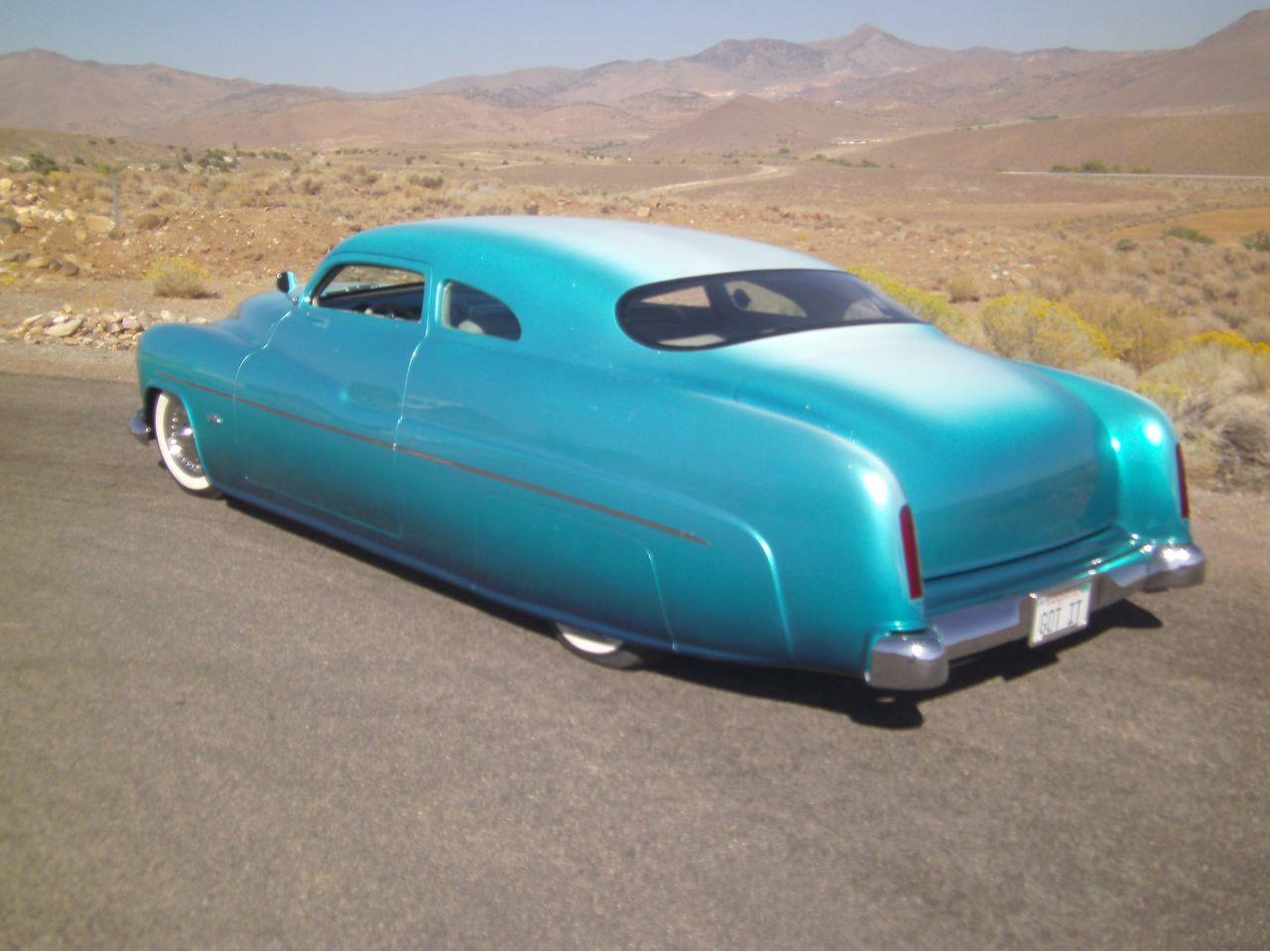
If you need another reason, then consider this: this custom Mercury has Gene Winfield’s fingerprints all over it. Says the seller, a cousin of the owner, “This Merc was my cousin Teddy’s pride and joy. His good friend Gene Winfield built it for him. [It even] has its own website: GotItMerc.com”. It’s appeared in magazines like Kustoms Illustrated (twice!), Car Kulture DeLuxe, and Custom Rodder.
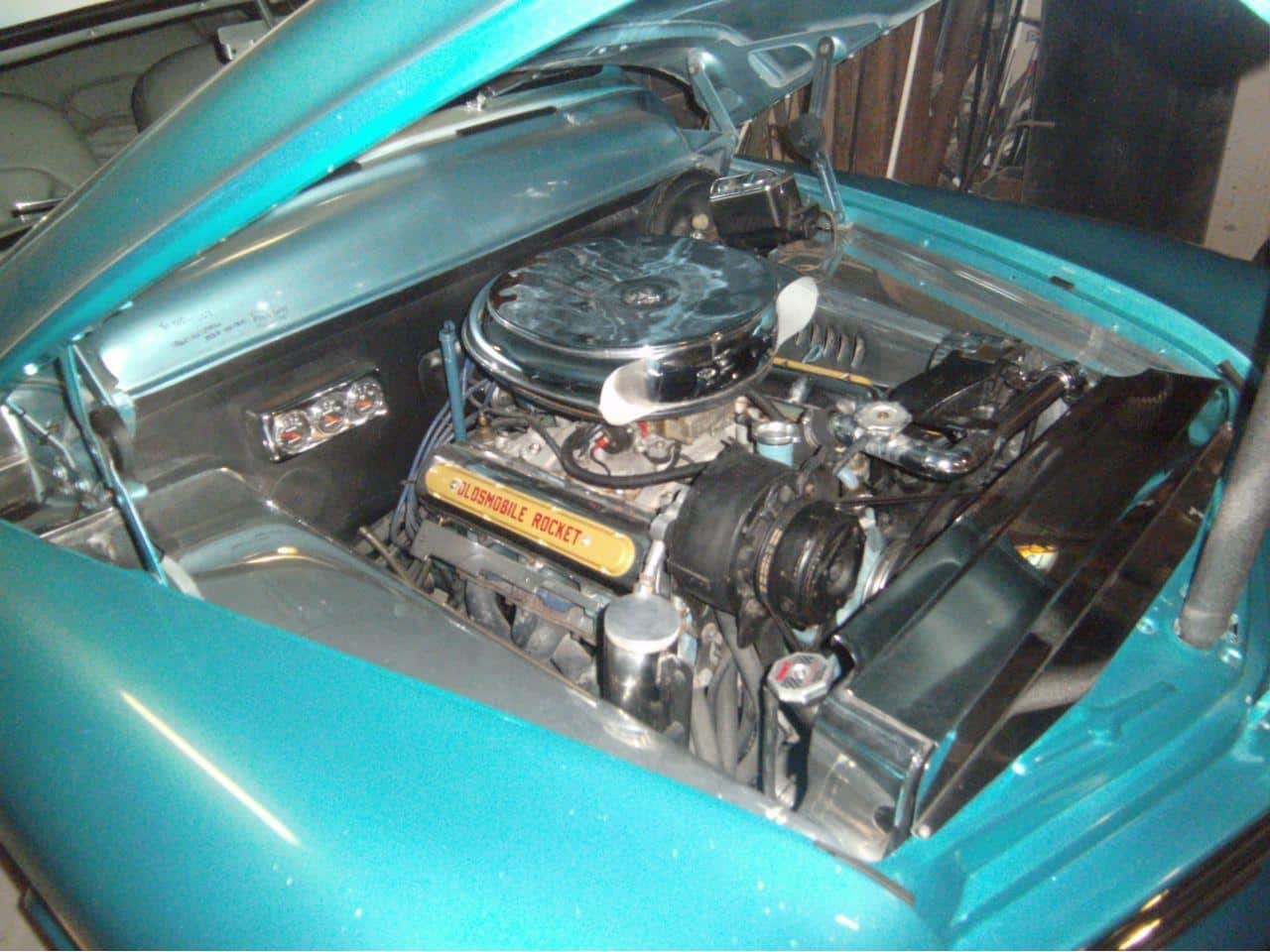
Of course, this Mercury has all the usual modifications that make a lead sled Merc what it is, such as chopped roof, channeled and flared body, frenched headlights, custom grille and narrowed bumpers. Power comes from a Joe Reath-built 403 Oldsmobile small-block that is bored, balanced and cammed, with a TH400 automatic putting it all in motion. Frame and suspension are from a 1978 Oldsmobile sans air-bag conversion. Inside, you’ll find conveniences like gray leather interior with blue inlays, AM/FM Secret Sound radio, air conditioning, and power steering and brakes. The icing on the cake is a Winfield fade paint job.
Seller adds, “The car is showing some age on the paint. It had supposedly been sold to a collector but that never really happened, and it took two years to get the car back, and it had not been pampered like it should have.” Car is currently properly stored in Carson City, Nevada with the former owner’s son, the nephew of the seller.
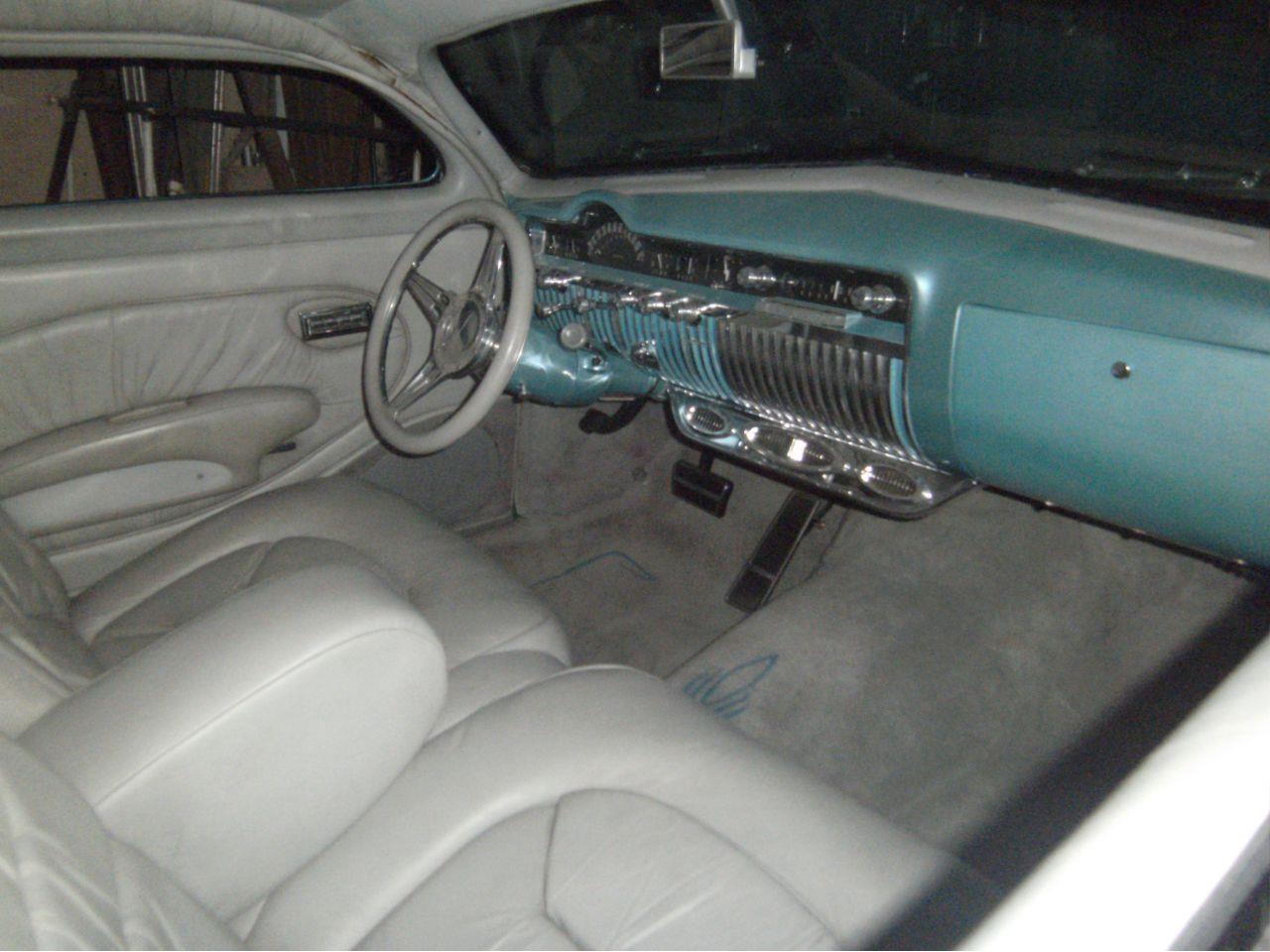
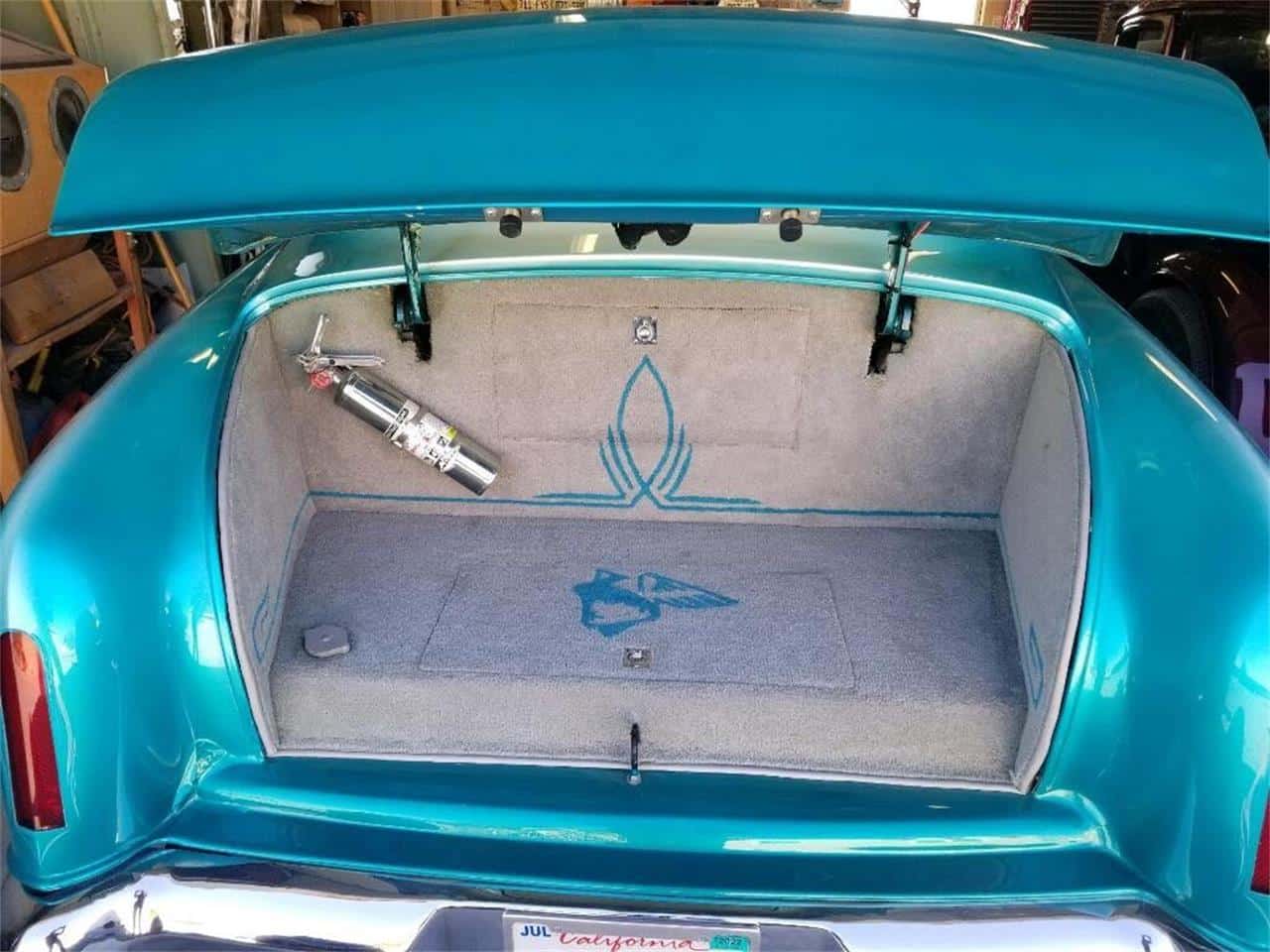
“It was appraised at $180,000 after completion and now is being sold at a fraction of that figure.” That price is $80,000. The Merc has a clear California title and is being represented by the estate of the owner.
To view this listing on ClassicCars.com, see Pick of the Day.
All treats (well, maybe a few tricks) this weekend with car shows. While we can’t mention every single show happening this weekend, we’ve picked a few to highlight, and are sharing some sites to find shows closer to you, including all those Halloween events. If you are involved in a local show coming up, please feel free to leave a comment about it!
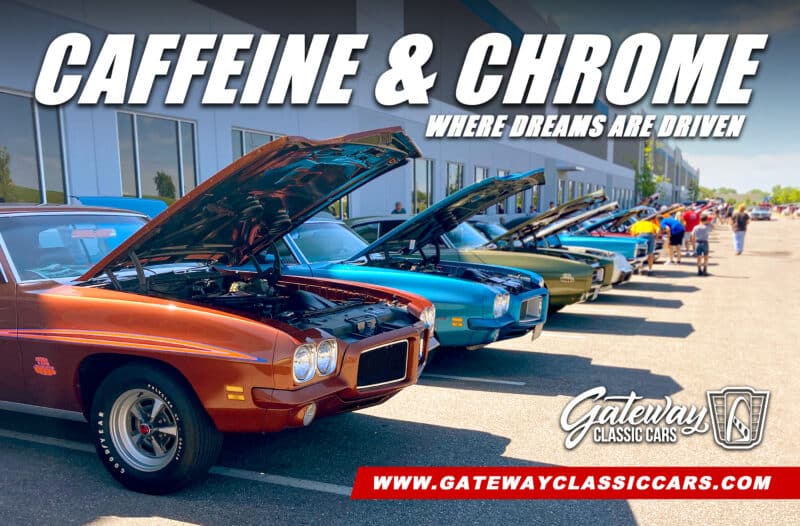
Gateway Classic Cars: Caffeine and Chrome- Truck or Treat
October 29, Nationwide, 21 locations
Gateway Classic Cars offers Caffeine and Chrome on the last Saturday of every month, but the October one is themed for Halloween! You can attend any of the 21 locations this Saturday to participate. View the list of locations here.
The House that Newman/Haas Racing Built- Sotheby’s Auction
October 29, Lincolnshire, IL
This one is for the racing fans. For the first time, the artifacts of Haas’ success are being offered to the public. Featuring over 40 cars and Haas memorabilia, you can own a piece of history. Or, at least, catch a glimpse of it before others buy it.
SEMA 2022
November 1-4, Las Vegas, NV

The 2022 SEMA show begins on Tuesday, so we count that close enough to this weekend for you to prepare. If you haven’t already registered to attend, learn more here. What’s great about SEMA is that it’s the best combination of a car show and a trade show. There will be over 70 education sessions you can attend for free.
Fall 2022 Car Show & Concours d’Lemons
October 29, Texarkana, AR
I’m booking my flight to Texarkana immediately, because this is the first Halloween Concours d’Lemons I’ve come across. Hosted by the Four States Auto Museum, come out to this show and decorate your car for Halloween.
Nothing highlighted from your region? Be sure to check out these resources for all variety of car events, especially those trunk-or-treats:
Since August, Dodge has announced special “Last Call” models for 2023 before the brand goes EV on us. Now, the Auburn Hills-by-way-of-Highland-Park automotive company has just announced that Dodge has opened up ordering for 2023 Dodge Challenger and Charger Last Call models.
If you visit DodgeGarage.com, you can use the new Dodge Horsepower Locator online tool to find dealers authorized to order your favorite Last Call Dodge. You can search by ZIP code, model, special-edition and trim level. The Dodge Horsepower Locator also tracks dealership allocations (not inventory), which gives you the ability to see all 2023 Dodge Challenger and Charger models still available for ordering from a respective dealership.
“Dodge has been building special-edition muscle cars for the last decade, and we have yet to find an allocation methodology that satisfies everyone. Our new ‘Last Call’ Horsepower Locator isn’t going to satisfy everyone either, but it’s our attempt to take the mystery out of it,” says Dodge brand chief executive officer, Tim Kuniskis. “We’re making the process as transparent as possible, giving enthusiasts the power to search for each 2023 model and trim level allocated to each dealer. Our enthusiasts will have every opportunity to locate the Dodge ‘Last Call’ model they desire.”
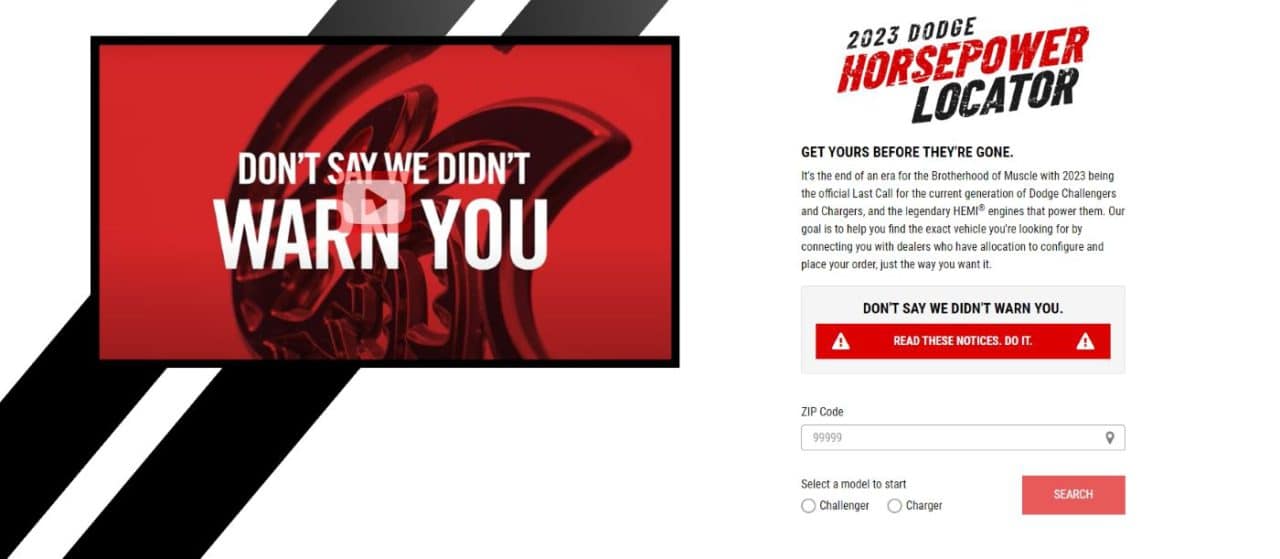
So how is that allocation derived? The top 500 dealerships in Challenger and Charger sales qualify, with the top 200 dealers receiving 12 of the special-edition models, the top 201-300 receiving 10 and the top 301-500 receiving six.
In case you have forgotten which 2023 Last Call Dodges have been announced thus far, here’s a list:
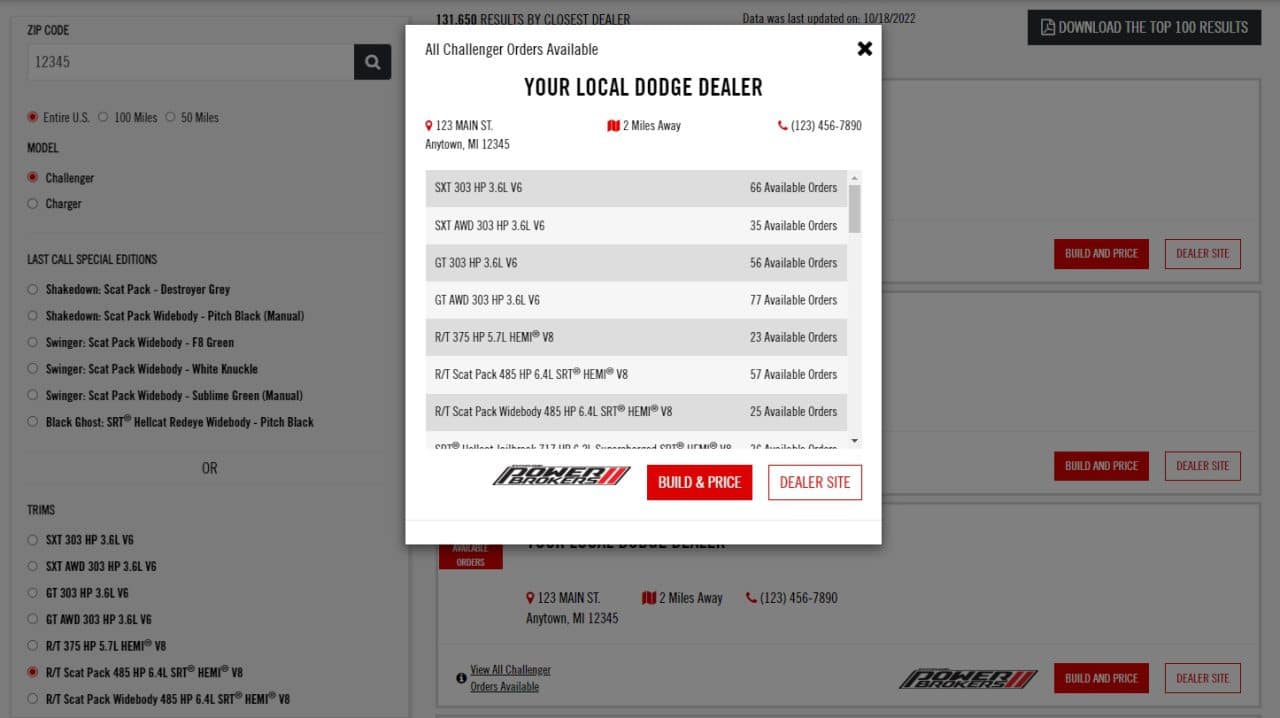
The seventh and final Last Call model, which was slated to be announced at the SEMA show next week, will instead be announced at a later date. Supply chain issues? Don’t want to disrupt the upcoming election? We can only speculate.
When you order from a dealer with the specified allocation, your Last Call order will be confirmed within 30 days via email, followed by updates to keep you abreast of your car’s production status.
Additionally, Dodge will be expanding the reach of its SRT Jailbreak models, with all 2023 Challenger and Charger SRT models (save Last Call special-editions and Super Stock) being designated Jailbreak models. This includes SRT Hellcats, meaning interested parties can built their own quasi-bespoke SRT Hellcat and Hellcat Redeye Challengers and Chargers. Previously, only Challenger and Charger SRT Hellcat Redeye Widebodies were the sole Jailbreak models.
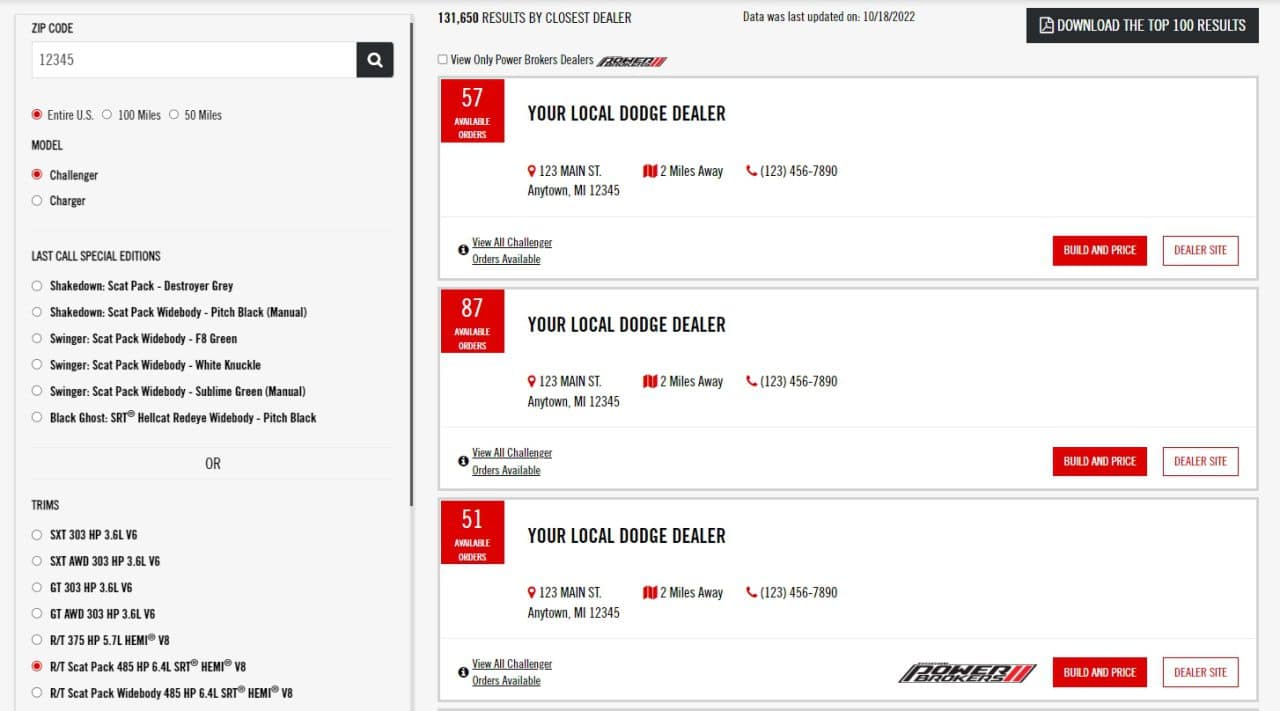
And, in even more news, Dodge will be bringing back three “heritage” colors that include B5 Blue, Plum Crazy purple and Sublime green, plus the more modern Destroyer Grey.
All this got ya excited? Then let’s hope you can afford your favorite because this is gonna get pricey! Keep in mind that the below prices are simply MSRPs and do not include $1,595 in destination and fees.
This 1932 Ford custom roadster was professionally built from the ground-up to show-quality standards. Previously owned by Richard Rawlings of Gas Monkey Garage, the all-steel Ford is finished in Plum Crazy Purple metallic, laser-straight and fully sanded and buffed to a mirror finish, with pinstripes laid out by Daniel Gay. The fully boxed chassis is as nicely detailed as the body, featuring a chrome dropped front axle with Vega steering box and chromed hairpins. The rear is a Currie nine-inch differential with chrome ladder bars. Hydraulic brakes with period-correct Buick finned front drums and custom Wilson backing plates handle stopping chores.
Power comes from an HC-code 327ci small-block topped with six Stromberg carburetors on an Offenhauser intake, plus custom Rams Horn exhausts with functional cutouts, all backed by a Muncie four-speed transmission. The two-tone black and white tuck and roll interior, inspired by the Tom McMullen roadster, features a “glide” adjustable front seat. Another interior highlight is the Mooneyes engine-turned Auburn-style dash panel. All this rolls on chrome Smoothie Mercury rims with Firestone wide whitewall tires.
Check out Jeff’s latest 4K video and many others at AutoHunter’s YouTube channel.